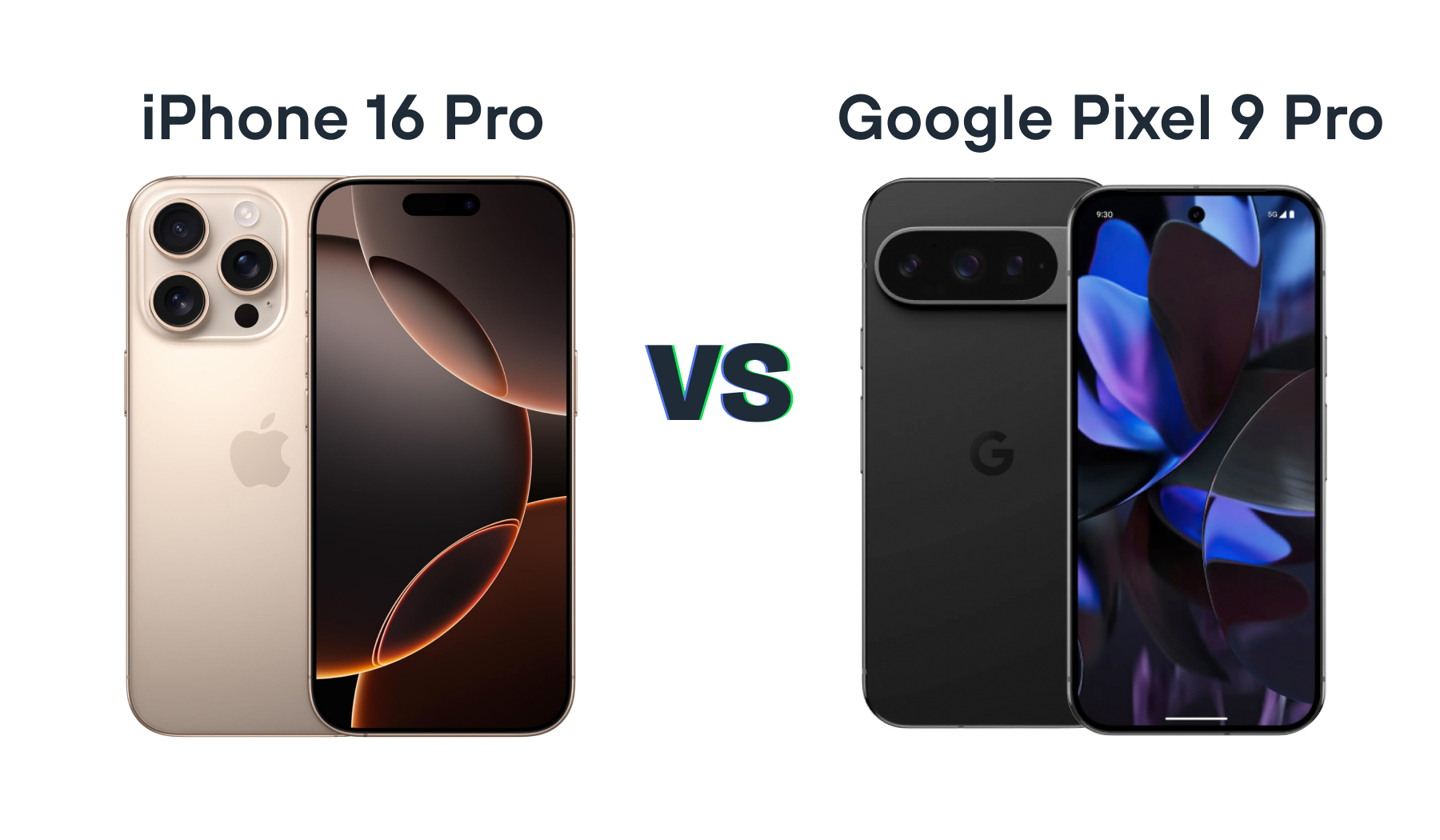Seven months in, the iPhone 16 Pro and Pixel 9 Pro are well past their launch hype, settling into everyday use. With Google’s August refresh bringing four new Pixels and Apple’s “It’s Glowtime” event debuting the iPhone 16 lineup, both companies finally delivered premium features in smaller bodies.
For years, compact phone fans had to compromise, but 2025 has changed that. Apple and Google have packed their best tech into 6.3-inch flagships, making the iPhone 16 Pro nearly identical to its Max sibling, while Google shifted its biggest model to a new “Pro XL” tier.
At a glance and on paper, these two have more in common than ever—flat sides, a familiar 6.3-inch display, and even a Pixel design that now leans toward Apple’s squared-off aesthetic. But beyond the surface, there are key differences in battery life, camera performance, and day-to-day usability.
We’ve put both devices through their paces to see which one comes out on top. Let’s dive in.
See Also: Google’s Pixel 9 lineup: 7 features that outshine the Pixel 8 series (And what’s still missing)
Specs Comparison: Pixel 9 Pro vs. iPhone 16 Pro
| Google Pixel 9 Pro | iPhone 16 Pro |
|---|---|
| Slightly larger than the iPhone 16 Pro | A more compact design |
| 6.3-inch display, adaptive 1-120Hz refresh rate | 6.3-inch ProMotion display, 120Hz refresh rate, 1-nit minimum brightness |
| Triple-camera setup with a 50MP main sensor, 48MP ultrawide, and 48MP telephoto with 5x optical zoom | Similar camera setup with a 48MP stacked main sensor, 48MP ultrawide, and tetraprism telephoto with 5x zoom |
| More RAM at 16GB | 8GB RAM, but optimised well for iOS |
| Starts at 128GB storage | Starts at 256GB storage, doubling the Pixel’s base model |
| Bigger 4,700mAh battery, likely offering longer battery life | Smaller 3,582mAh battery |
| Powered by Tensor G4, which still lags behind Snapdragon and Apple silicon in benchmarks | A18 Pro chip with better thermal efficiency, reducing heat by 20% for improved performance |
| 45W wired charging, significantly faster than the iPhone | Slower wired charging but supports MagSafe wireless charging |
Design: Pixel 9 Pro vs. iPhone 16 Pro
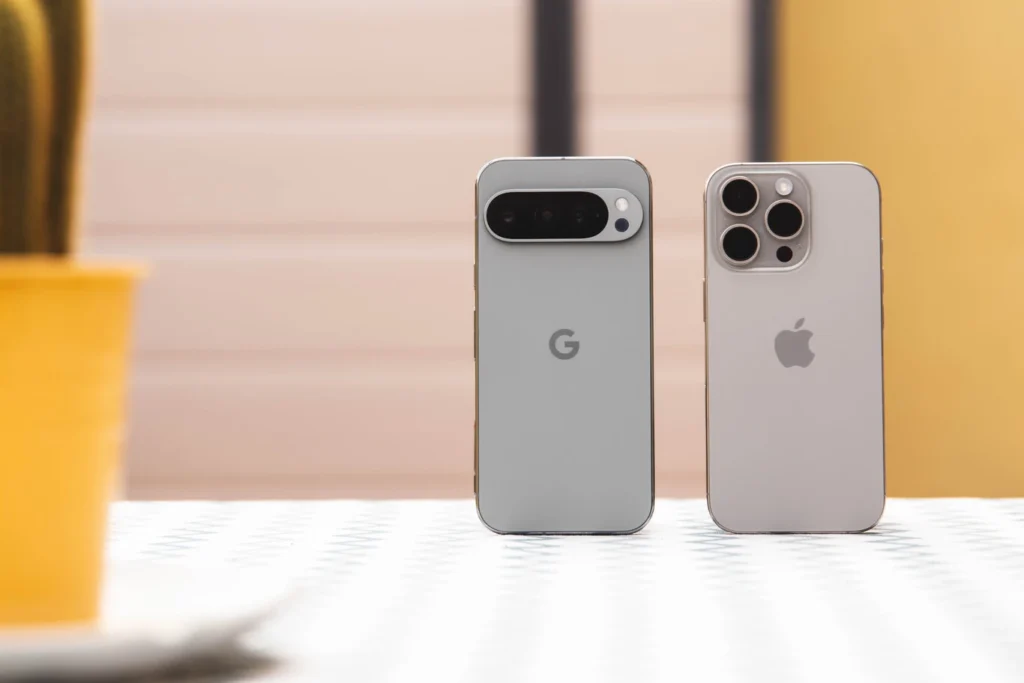
This year, Apple and Google have unintentionally met in the middle when it comes to size. The iPhone 16 Pro is slightly larger than its predecessor with a 6.3-inch display, while the Pixel 9 Pro has slimmed down to the same dimensions, making room for the new Pixel 9 Pro XL. The result being two flagships that are remarkably similar in footprint but still distinct in design.
The Pixel 9 Pro moves away from Google’s signature full-width camera bar, opting for a raised module that stops short of the edges. The redesign, combined with flat sides and a more squared-off frame, makes the Pixel look and feel closer to an iPhone than previous models. That said, it still carries Google’s design language with its aluminium chassis and chamfered edges that soften the overall feel.
The iPhone 16 Pro, meanwhile, sticks closely to the formula introduced with the 15 Pro. The titanium frame remains, as does the matte glass back and squared-off edges. But this time, Apple has added a second programmable button alongside the Action button—the Camera Control button, designed for quick access to camera functions. It’s a small but practical change that integrates deeper into the iPhone experience.
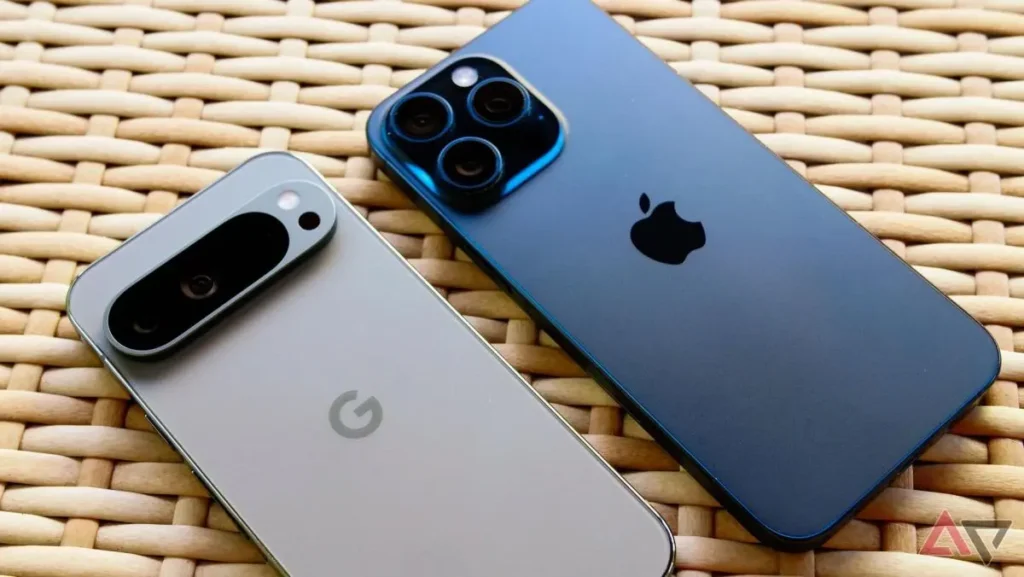
At a glance, the differences are subtle. The Pixel’s display is just slightly wider, its bezels a touch thicker, and its design more angular. The iPhone, on the other hand, has its signature Dynamic Island instead of a hole-punch camera and a square camera module rather than the Pixel’s horizontal bar. The materials also differ, but in day-to-day use, the difference between titanium and aluminium isn’t all that noticeable.
Both phones refine their predecessors’ designs rather than reinvent them, but the Pixel’s shift toward a flatter, more structured aesthetic makes it feel like a bigger departure. Apple has focused on refining rather than changing, while Google has continued its pattern of annual design tweaks—this time, landing closer to Apple than ever before.
Winner: iPhone 16 Pro.
Display: Pixel 9 Pro vs. iPhone 16 Pro
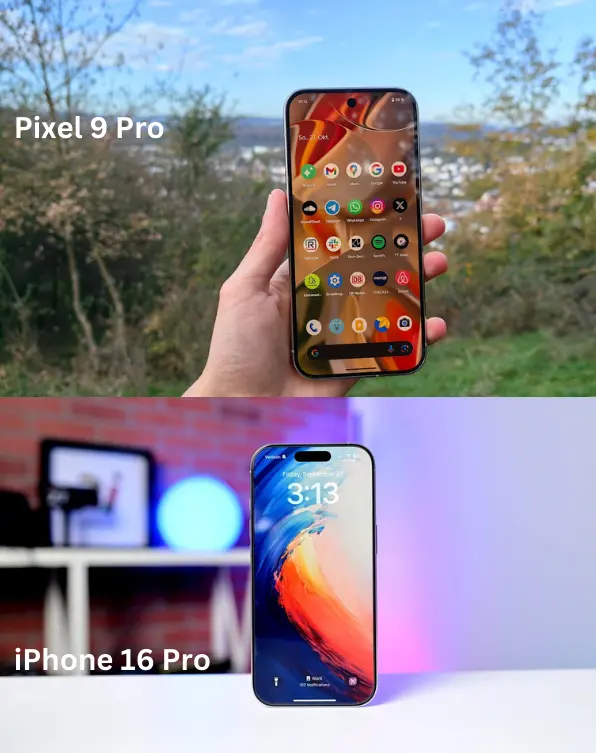
Both phones feature a 6.3-inch OLED display with a smooth 120Hz refresh rate, that adjusts dynamically to save battery when needed. The resolution difference—1280 x 2856 on the Pixel 9 Pro versus 2622 x 1206 on the iPhone 16 Pro—is negligible in day-to-day use.
Brightness, however, is a different story. The Pixel 9 Pro pushes up to 3,000 nits, making it one of the brightest displays on the market, while the iPhone 16 Pro peaks at 2,000 nits. Outdoors, this could give Google’s phone an edge in direct sunlight. At the other end of the scale, Apple claims the iPhone 16 Pro can dim down to just 1 nit, a feature that could be useful for nighttime reading, though real-world impact remains to be seen.
In terms of durability, Apple sticks with its Ceramic Shield, while the Pixel 9 Pro uses Gorilla Glass Victus 2. Both are tough, but without clear comparisons, it’s hard to say which one offers better protection.
One noticeable difference is the front camera design. The iPhone 16 Pro keeps its Dynamic Island, while the Pixel 9 Pro opts for a minimal hole-punch cutout, making Apple’s implementation look much larger in comparison.
Winner: Pixel 9 Pro.
Performance and Storage: Pixel 9 Pro vs. iPhone 16 Pro
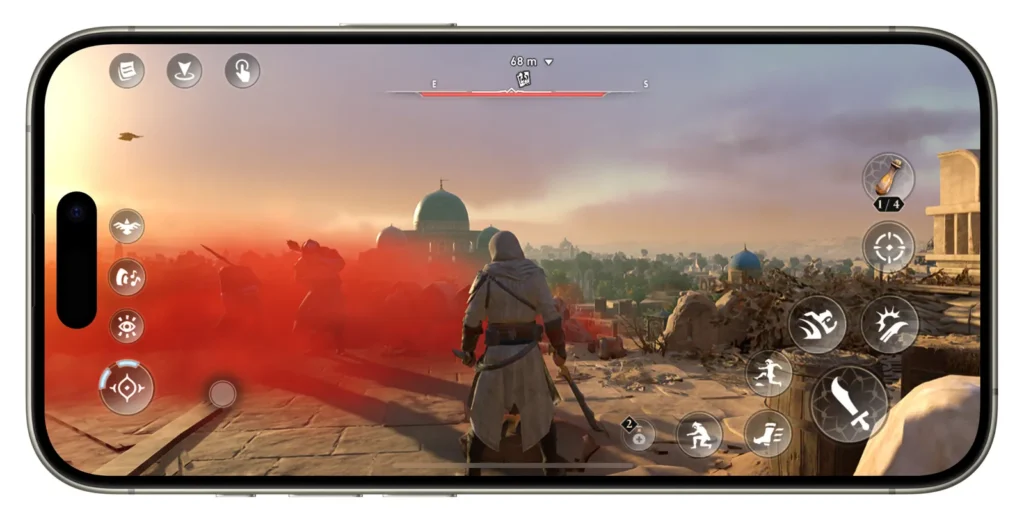
Smartphone hardware is reaching a point where raw power isn’t the main differentiator anymore. AI is taking centre stage, shaping how these devices perform and interact with users. While both Apple and Google emphasise on-device AI, a lot of the heavy lifting still happens in the cloud. That said, the chip inside your phone still matters—especially for efficiency and sustained performance.
The iPhone 16 Pro introduces the A18 Pro, an upgraded chipset with a redesigned cooling system that Apple claims improves heat management by 20%. This should mean better performance under sustained load, addressing some of the overheating concerns from previous models. On the Pixel 9 Pro, Google continues with its in-house Tensor series, equipping the phone with the Tensor G4. While Google’s chips haven’t been performance leaders in traditional benchmarks, they’re optimised for AI-driven tasks, which play an increasing role in everyday usage.
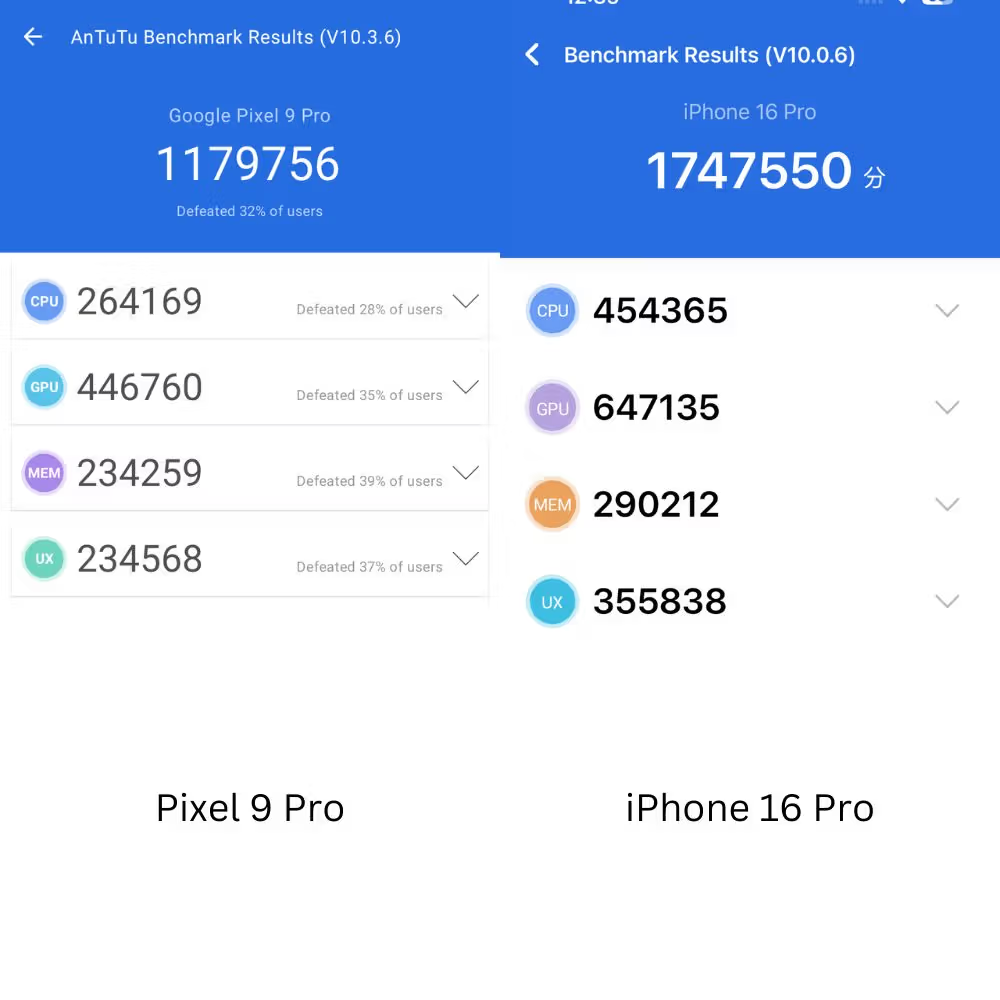
RAM is another key difference. The Pixel 9 Pro packs 16GB, likely to support its AI features, while the iPhone 16 Pro sticks with 8GB. iOS is more efficient with memory, but as AI models grow and demand more resources, having extra RAM could prove useful in the long run. Both devices also support Wi-Fi 7, ensuring they’re future-proofed for faster connectivity.
When it comes to raw speed, Apple’s A-series chips continue to lead. The A18 Pro is expected to outperform the Tensor G4 in benchmarks, just as its predecessors did against earlier Tensor chips. But real-world performance tells a different story—Pixels have never been sluggish in daily use, and the G4 refines some of the issues seen in past generations. If Apple’s cooling redesign delivers, the iPhone 16 Pro should maintain its lead in sustained performance. But if it struggles with heat, that advantage could narrow.
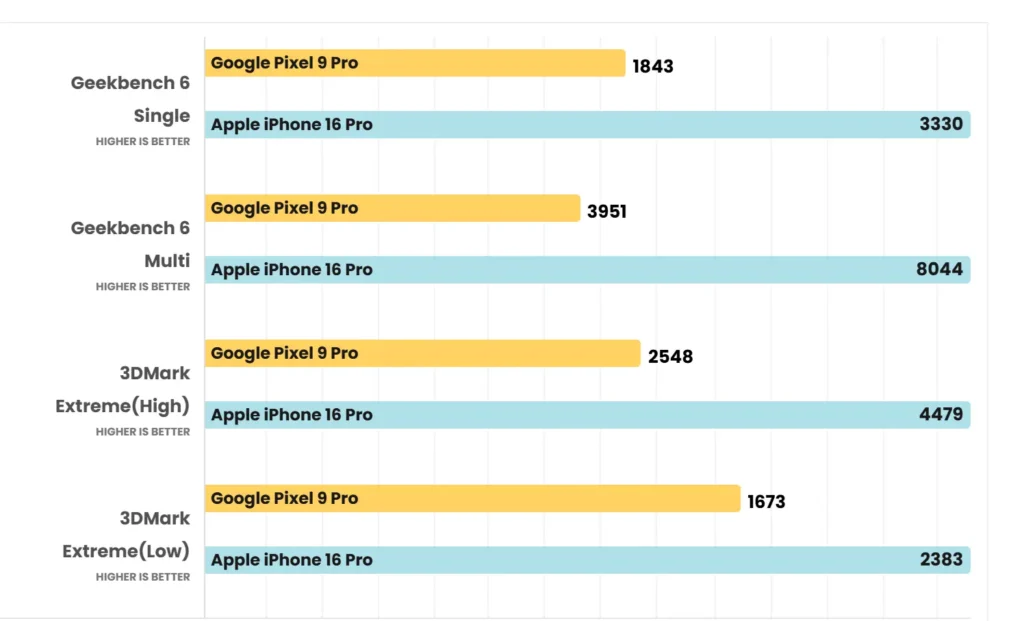
Winner: For now, the iPhone 16 Pro takes this round on sheer processing power.
Software: Pixel 9 Pro vs iPhone 16 Pro
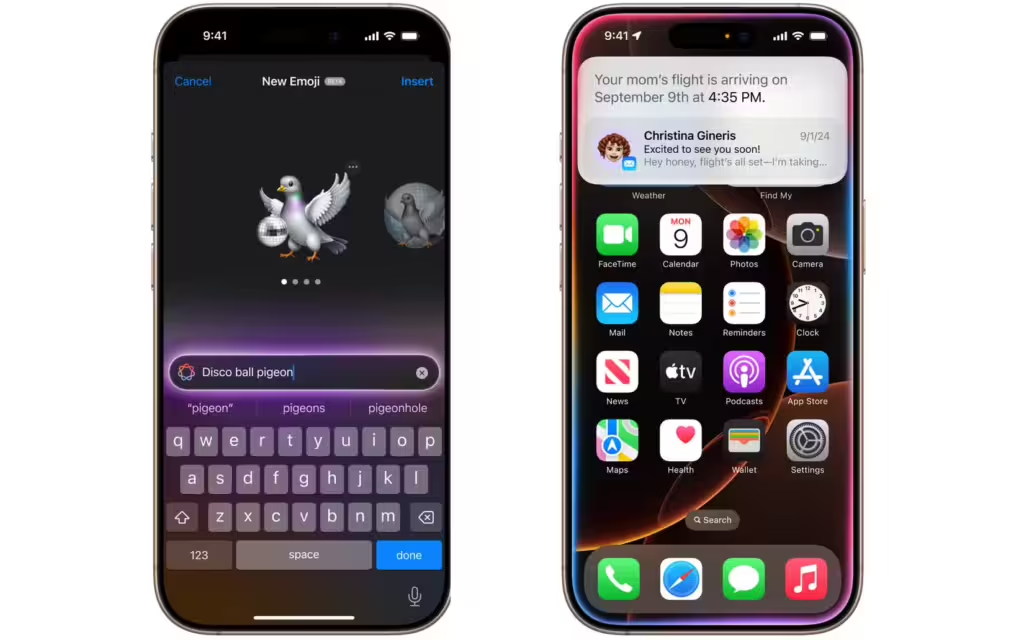
Apple made a big splash with its AI push at the “It’s Glowtime” event, introducing Visual Intelligence, AI-driven Photographic Styles, and Audio Mix Styles. The catch is most of these features are still in beta, with no clear timeline for a full release. Even Siri’s much-anticipated overhaul isn’t expected until iOS 18.3 in March 2025.
Meanwhile, iOS 18.1 and 18.2 have rolled out the first wave of Apple Intelligence, bringing features like notification summaries, writing tools, Clean Up in Photos (Apple’s take on Magic Eraser), and ChatGPT integration. But if you’re buying a phone for AI right now, the Pixel 9 Pro is the safer bet. Google’s AI suite—Gemini, Pixel Studio, Pixel Screenshots, and AI-powered camera tools—is available from day one, with no waiting required.
Software support also leans in Google’s favour. The Pixel 9 Pro gets seven years of major Android updates, while Apple historically provides around five. iPhones tend to age well, but Google’s official guarantee adds extra peace of mind.
Winner: Pixel takes the win.
Camera: Pixel 9 Pro vs iPhone 16 Pro
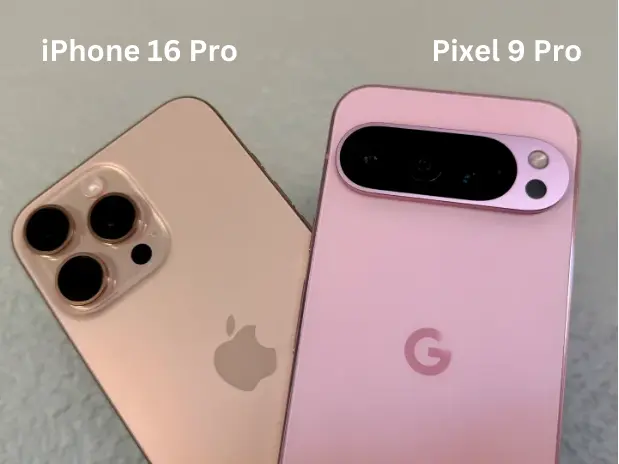
Both the iPhone 16 Pro and Pixel 9 Pro bring flagship-level cameras in compact designs, but the approach each brand takes makes all the difference. Google sticks with high-megapixel sensors across the board, featuring a 50 MP main camera, a 48 MP ultrawide, and a 48 MP periscope zoom with 5x optical zoom. Apple, on the other hand, pairs a 48 MP main sensor with a 48MP ultrawide and a 12MP telephoto lens, leveraging its well-tuned image processing to maintain sharpness and detail.
In daylight, both phones deliver crisp images with strong dynamic range, but the iPhone tends to preserve a more natural look, while the Pixel leans into computational photography with richer contrast and AI-driven enhancements. This becomes more apparent in portrait shots, where the Pixel applies an aggressive background blur, even outside of portrait mode, while the iPhone maintains a more controlled depth effect.
Low-light performance sees the Pixel benefiting from its brighter ultrawide lens, which helps capture more detail in dark scenes. Meanwhile, Apple’s improvements in video recording stand out, especially with 4K at 120fps—an advantage over the Pixel’s 4K at 60fps. The iPhone also introduces the new Camera Control button, offering a more tactile shooting experience with swipe gestures for zoom and exposure adjustments.
For ultrawide shots, the iPhone captures sharper images, though some may find them a bit overprocessed, while the Pixel takes a softer, more natural approach. Zoom capabilities are close, with both offering 5x optical zoom, but Google’s higher-resolution telephoto sensor helps retain more detail at a distance.
Selfies remain a close call, with both phones excelling in skin tones and exposure. However, the Pixel handles bright backgrounds slightly better, keeping highlights from blowing out.
Overall, the Pixel 9 Pro offers more detailed zoom shots and a brighter ultrawide for low-light, while the iPhone 16 Pro shines in video recording, colour accuracy, and its refined camera app experience.
Winner: Tie.
Battery life and Charging: Pixel 9 Pro vs iPhone 16 Pro
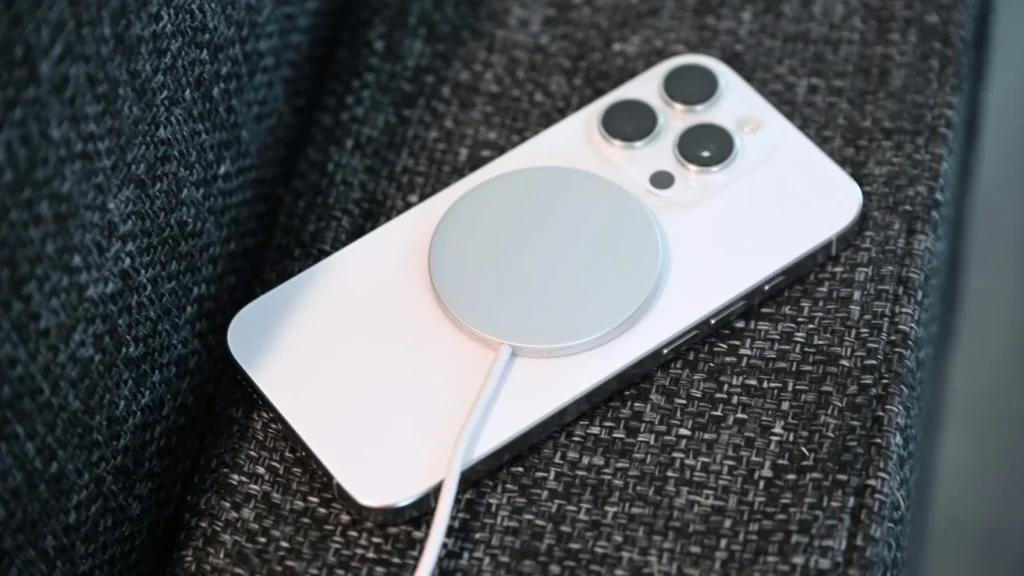
Battery life on the Pixel 9 Pro should, in theory, have the edge with its larger 4,700 mAh battery, but Apple’s tight software-hardware integration often levels the playing field. The iPhone 16 Pro’s battery capacity isn’t officially listed, but real-world usage suggests it’s designed to last through a full day, much like Google’s claim of “24+ hours” for the Pixel. If previous trends hold, Apple’s efficiency should keep it close, though the Pixel might stretch a little further under heavy use.
Charging is a closer battle. Google pushes ahead with 45W wired charging, getting you back up and running faster than the iPhone’s 20W limit. Wireless charging is a mixed bag—MagSafe hits 15W, slightly ahead of the Pixel’s standard Qi speeds, but Google’s Pixel Stand boosts wireless charging to 21W. If fast-wired top-ups matter more, the Pixel wins. If you’re all-in on MagSafe accessories, the iPhone holds its own.
Winner: Pixel 9 Pro.
Which one should you buy?
The iPhone 16 Pro and Pixel 9 Pro are both great phones, and there’s not a huge gap between them. The iPhone is more powerful, works seamlessly with Apple devices, and will soon get new AI features. The Pixel 9 Pro, however, gives you Google’s AI tools right away, lasts longer on a charge, and charges faster. It also gets seven years of updates, making it a solid long-term pick.
With so few major differences, switching platforms is a bigger decision than choosing between these two phones. If you prefer Apple’s polished, connected experience, go with the iPhone 16 Pro. If you value Android’s flexibility and Google’s AI edge, the Pixel 9 Pro is the smarter choice. Google also tends to offer discounts, so you might find it for less.
Either way, you’re getting a top-tier phone.
| Features (5 points) | Pixel 9 Pro | iPhone 16 Pro |
|---|---|---|
| Design | 4 | 5 |
| Display | 5 | 4 |
| Software | 5 | 4 |
| Chipset | 4 | 5 |
| Battery | 5 | 5 |
| Camera | 5 | 4 |
| Total | 28 | 27 |
Pricing and availability
The Pixel 9 Pro and iPhone 16 Pro both come in four storage options: 128GB, 256GB, 512GB, and 1TB. Their pricing is nearly identical, except at the top tier, where the Pixel undercuts the iPhone by $250.
| Storage | iPhone 16 Pro | Pixel 9 Pro |
|---|---|---|
| 128GB | $999 (₦1,522,725) | $799 (₦1,217,875) |
| 256GB | $1,099 (₦1,675,150) | $899 (₦1,370,300) |
| 512GB | $1,299 (₦1,980,000) | $1,019 (₦1,553,210) |
| 1TB | $1,499 (₦2,284,850) | $1,249 (₦1,903,788) |
The Pixel 9 Pro launched in August 2024, with a starting price of $799 for the 128GB model. It’s available in Porcelain, Hazel, Rose Quartz, and Obsidian. Meanwhile, the iPhone 16 Pro starts at $999, with the new Desert Titanium colour joining Natural Titanium, White Titanium, and Black Titanium.
Both phones can be purchased directly from Apple and Google, as well as through authorised retailers.
Get passive updates on African tech & startups
View and choose the stories to interact with on our WhatsApp Channel
Explore
